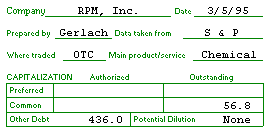 |
|
||||||||||||
|
Stock Selection Guide Tutorial
General Information & Capitalization General InformationAt the top of the SSG form is an area to record some general information about your stock study. This information is for your own reference, and most of the fields are fairly self-explanatory.
CapitalizationIn this area, information is recorded about a company's capital structure. Capitalization is simply the way a business is financed, including common and preferred stock, long-term debt and retained earnings. The figures in this section are not used for any calculations, but rather serve as "flags" to potential problems.

|
